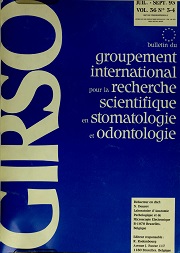Light and Laser Scanning Microscopy analysis of hydroxyapatite used in periodontal osseous defects in man: evidence of a different resorption pattern in bone and soft tissues
Keywords:
biodegradation, hydroxyapatite, Laser Scanning Microscopy, multinucleated cellsAbstract
Hydroxyapatite (HA) is a highly biocompatible material that recently has been shown to undergo biodegradation. The mechanisms of this phenomenon are unclear, and humoral and cellular events have been thought to be implicated. In the present study HA particles were put into infraosseous defects on teeth that were to be extracted for prosthetic reasons and then retrieved after a 1 year period. The specimens were processed with the cutting grinding system. Results show a very sharp difference of the biodegradation processes, related to the tissues that surround the HA particles. HA in tight contact with mineralized bone showed no evidence of degradation or resorption, while on the contrary, in the areas where bone loose connective tissue was present, it was possible to observe HA crystals detached and scattered in cells cytoplasm or extracellular fluids. This dissolution and resorption phenomenon were observed also by Laser Scanning Microscope (LSM) in fluorescent mode. These differences in degrees of degradation between bone and loose connective tissue could be due to the small amount of interstitial fluid present in mineralized bone and the greater flow of fluid through connective tissue.
Downloads
Published
Issue
Section
License
I hereby certify that the authors of the above manuscript have all:
1. Conceived, planned, and performed the work leading to the report, or interpreted the evidence presented, or both;
2. Written the report or reviewed successive versions and shared in their revisions; and
3. Approved the final version.
Further, I certify that:
1. This work has not been published elsewhere and is not under revision in another journal;
2. Humane procedures have been followed in the treatment of experimental animals (if applicable);
3. Investigations in humans was done in accordance with the ethical standards of the responsible committee on human experimentation or with the Helsinki Declaration (if applicable).
4. This paper has been carefully read by a native English speaker who is familiar with the field of work (this applies to authors who are not fluent in English); and
5. The copyright of the article is transferred from the authors to the Bulletin du Groupement International pour la Recherche Scientifique en Stomatologie et Odontologie upon acceptance of the manuscript.



